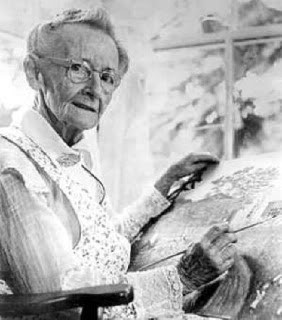Grandma Moses depicted simple scenes that reflected rural life and the countryside in the 1800s. She often featured families and communities in midst of honest, hard work exemplifying the traditional American way of life during that period. Such tasks as husking corn, butter churning, making soap and tending to livestock were characterized in her pictures portraying farm life.
She often painted seasonal pictures of Vermont, upstate New York and Hoosick Valley, from which she could see from her window. Many of the images were painted from memory, including the clothing, household items and furniture. Detailed and colorful, the landscapes appear one dimensional, the houses and trees patterned across the frame and the key figures seemingly flat. Reminiscent of child book illustrations, her style brought forth a sense of happiness and charm.
A Beautiful World
Most all of Grandma Moses’ paintings were painted on old pieces of wood, adding a certain authenticity to the composition. Her paintings were popular images for the holidays and were soon reproduced on Christmas cards, tiles and fabrics and distributed all over the world. Overall, she painted more than 1600 paintings.
A Checkered House
During the Depression she was trying to sell her paintings at the Women’s Exchange, when she was discovered by an art collector. By 1939, she had three showing at the Museum of Modern Art in New York City. She became a national icon in the 1950s and was cited by the National Press Club as being one of the five most newsworthy women of 1950. She even made an appearance on the Edward R. Murrow television show and her photo graced the cover of Time magazine in 1953. Despite her fame, Grandma Moses remained dedicated to her family and true to herself. “If people want to make a fuss over me, I let’em, but I was the same person before as I am now,” she once told reporters.











